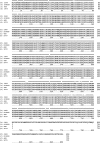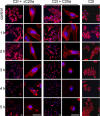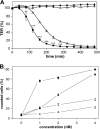Functional characterization of an extended binding component of the actin-ADP-ribosylating C2 toxin detected in Clostridium botulinum strain (C) 2300
- PMID: 20145093
- PMCID: PMC2849413
- DOI: 10.1128/IAI.01351-09
Functional characterization of an extended binding component of the actin-ADP-ribosylating C2 toxin detected in Clostridium botulinum strain (C) 2300
Abstract
Clostridium botulinum C2 toxin consists of the binding component C2II and the enzyme component C2I, which ADP-ribosylates G-actin of eukaryotic cells. Trypsin-activated C2II (C2IIa) forms heptamers that mediate cell binding and translocation of C2I from acidic endosomes into the cytosol of target cells. By genome sequencing of C. botulinum strain (C) 2300, we found that C2II from this strain carries a C-terminal extension of 129 amino acids, unlike its homologous counterparts from strains (C) 203U28, (C) 468, and (D) 1873. This extension shows a high similarity to the C-terminal receptor-binding domain of C2II and is presumably the result of a duplication of this domain. The C2II extension facilitates the binding to cell surface receptors, which leads to an increased intoxication efficiency compared to that of C2II proteins from other C. botulinum strains.
Figures






References
-
- Barth, H., D. Blöcker, J. Behlke, W. Bergsma-Schutter, A. Brisson, R. Benz, and K. Aktories. 2000. Cellular uptake of Clostridium botulinum C2 toxin requires oligomerization and acidification. J. Biol. Chem. 275:18704-18711. - PubMed
-
- Barth, H., R. Roebling, M. Fritz, and K. Aktories. 2002. The binary Clostridium botulinum C2 toxin as a protein delivery system: identification of the minimal protein region necessary for interaction of toxin components. J. Biol. Chem. 277:5074-5081. - PubMed
-
- Binz, T., and A. Rummel. 2009. Cell entry strategy of clostridial neurotoxins. J. Neurochem. 109:1584-1595. - PubMed
-
- Blöcker, D., K. Pohlmann, G. Haug, C. Bachmeyer, R. Benz, K. Aktories, and H. Barth. 2003. Clostridium botulinum C2 toxin: low pH-induced pore formation is required for translocation of the enzyme component C2I into the cytosol of host cells. J. Biol. Chem. 278:37360-37367. - PubMed
Publication types
MeSH terms
Substances
Associated data
- Actions
LinkOut - more resources
Full Text Sources
Miscellaneous

